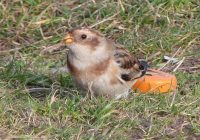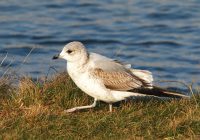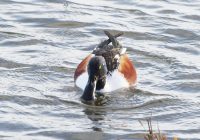Dr Phil Smith’s Wildlife Notes
January 2015
January was slightly milder than usual and had average rainfall, this having little effect on the dune water-table which remained stubbornly low. Checking the ponds on Freshfield Dune Heath Nature Reserve on 4th, I found them about 2 feet (60cm) below maximum level. However, lots of flowering Gorse and singing Great Tits raised the spirits a little, as did some spectacularly large plants of Intermediate Polypody fern in the woodland.
With few notable birds about this month, I decided to check out a Snow Bunting supposedly showing well at Hall Road, Blundellsands. Needless to say, I just missed it and had to be content with a flock of about 150 noisy Starlings squabbling for food scraps in the carpark, while an icy wind came in off the sea. Dave Hardaker sent me an excellent photo of the bird taken a day or two earlier.
Later in the month I also missed out on a Long-tailed Duck at Crosby Marina which had been there for ages but not the day I chose to visit. All I could see on the marine lake were two Great Crested Grebes and eight Cormorants, so I amused myself photographing first-winter and adult Common Gulls on the small boating lake.
I joined a West Lancashire Wildlife guided walk at Marshside on 24th, timed to take advantage of a 9.9m tide. However, high atmospheric pressure meant it didn’t flood in as far as expected and the flypast of waterfowl was not up to the usual standard. Nevertheless, a walk along the old sand-extraction road to the tide edge was rewarded by several thousand waders, mostly Knot, with a scatter of Grey Plover, Redshank, etc. A large roost of Cormorants lined a sand-bank, while groups of elegant Pintails flew overhead. Hundreds of Skylarks were harassed by a dashing Merlin, a few Twite could be heard calling and a Marsh Harrier patrolled in the distance. Providing much-needed shelter from the biting wind, the RSPB hide gave close views of a variety of ducks, including Shovelers with their ridiculously large bills.
The following day saw me at the Alt Estuary where another large tide had displaced about 1600 Oystercatchers and 280 Curlews from their feeding grounds to roost in front of the Rifle Range. A Buzzard over the shore was an unusual sight, while one of many Black-headed Gulls already had a full-summer hood.
As frequently mentioned in these notes, scrub invasion, especially by the introduced Sea Buckthorn, is a major threat to our sand-dune flora and fauna. Following on from the volunteer “buckthorn bashes” in the autumn, Patricia Lockwood and I cleared scrub from two botanically rich slacks in the Birkdale frontals. Most of it was young, so easily dealt with using loppers but a few bushes were up to eight years old (according to annual ring counts), their trunks being three or four inches thick; my recent investment in a bow-saw proved invaluable. I also joined staff of Sefton Coast & Countryside and local Sand Lizard expert Mike Brown on a tour to plan future scrub-control operations on the dunes. With a recently discovered Sand Lizard colony, one of these sites is right next to a housing development proposed in the Sefton Local Plan. This is a concern that will need to be addressed, as the lizard and its habitat are strictly protected by law.
On the last day of the month, I spent a pleasant, if cold, hour at the National Trust’s Victoria Road Red Squirrel reserve. At least six of these delightful mammals were scampering about, entertaining the visitors. Surveys suggest that numbers have almost recovered to levels achieved before the parapox outbreak of 2007/08. Our squirrels have the dark-coloured fur of the continental subspecies, lacking white-tipped hairs in the tail and ear-tufts characteristic of the British race. There is ongoing debate about their origin. One suggestion is that they escaped in the 1940s from a captive group of continental Red Squirrels kept in a Formby garden. Certainly, they couldn’t have been here before pine trees were planted from the 1890s onwards.




